Lisnaskea, Co. Fermanagh
Lisnaskea Poor Law Union was formally declared on the 27th June 1840 and covered an area of 153 square miles. Its operation was overseen by an elected Board of Guardians, 18 in number, representing its 14 electoral divisions as listed below (figures in brackets indicate numbers of Guardians if more than one):
Co. Fermanagh: Agahvoory, Belleisle, Brooksborough (2), Callowhill, Colebrook, Derrycrum, Derrycullion, Donagh, Drumrelly, Killynick (2), Lisnaskea (2), Maguires Bridge (2), Manor Water House, Tomregan.
The population falling within the Union at the 1831 census had been 33,868 with divisions ranging in size from Derrycullion (population 1,504) to Maguires Bridge (4,116) and Lisnaskea itself (3,713).
The Board also included 6 ex-officio Guardians, making a total of 24. The Guardians met each week on Saturday at noon. Their inaugural meeting took place on 6th August 1840 when Sir Arthur Brooke was elected Chairman, Colonel Crichton Vice-Chairman, and Colonel Dickson Deputy Vice-Chairman. James Haire was appointed as clerk of the Union at a salary of £35 a year. Subsequent appointments included the workhouse master (£30 a year), the matron (£25 a year), school-master (£15 a year), and school-mistress (£12 a year). There were also Protestant and Catholic chaplains (£25 a year) and three doctors.
The new Lisnaskea Union workhouse was erected on a six-acre site to the south of Lisnaskea at the west side of the Newtownbutler Road. The land was bought from Lord Erne on 16th September 1841 for £336. Designed by the Poor Law Commissioners' architect George Wilkinson, the building was based on one of his standard plans to accommodate 500 inmates. Its construction cost £5,443 plus £1,021 for fittings etc. The workhouse was declared fit for the reception of paupers on 1st October 1842 and admitted its first inmates on 25th February 1843.
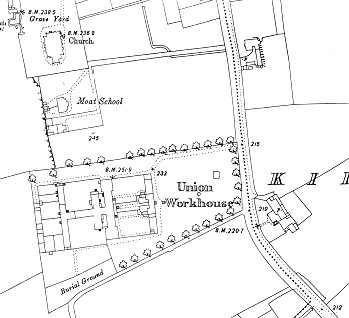
Lisnaskea workhouse site, 1905.
The buildings followed Wilkinson's typical layout. An entrance and administrative block at the east contained a porter's room and waiting room at the centre with the Guardians' board room on the first floor above. This was later extended at each side to provide children's accommodation and school-rooms.
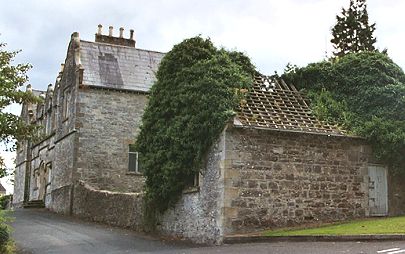
Lisnaskea entrance block from the north-east, 2003.
© Peter Higginbotham.
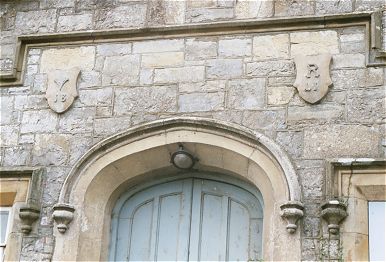
Lisnaskea entrance doorway and 1841 date plaque, 2003.
© Peter Higginbotham.
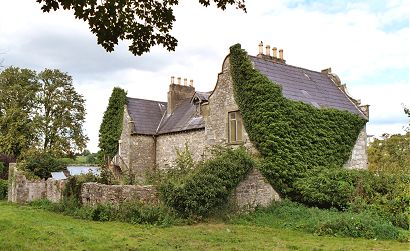
Lisnaskea entrance block from the south-west, 2003.
© Peter Higginbotham.
The main accommodation block had the Master's quarters at the centre, with male and female wings to each side.
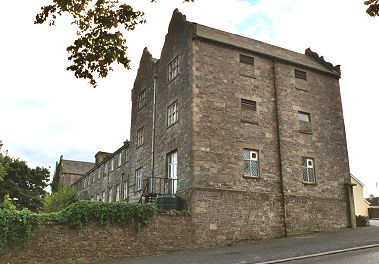
Lisnaskea main block from the north-east, 2003.
© Peter Higginbotham.
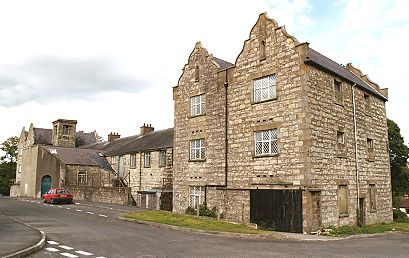
Lisnaskea main block from the south-west, 2003.
© Peter Higginbotham.
Ventilation towers in the roof of the main block were placed over the well-holes of internal staircases to improve the circulation of air through the building.
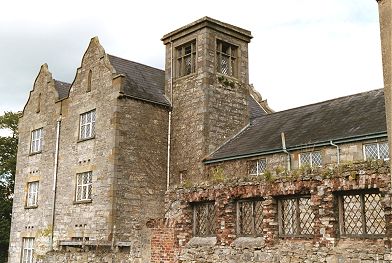
Lisnaskea ventilation tower from the south-west, 2003.
© Peter Higginbotham.
At the rear, a range of single-storey utility rooms such as bakehouse and washhouse connected through to the infirmary and idiots' wards via a central spine containing the chapel and dining-hall.
The early Guardians' minutes record that the male inmates were instructed in shoemaking, tailoring and weaving. They probably also helped with the maintenance of the building and the cultivation of potatoes in the workhouse grounds. Later on, the task of stone-breaking was introduced for male inmates.
Up until 1846, the inmates had two main meals a day, breakfast and dinner, consisting largely of potatoes. With the onset of the famine, this was replaced by Indian meal (maize) and oatmeal. From December 1846, under instruction from the Poor Law Commissioners, on two days a week, the inmates were to get a dinner of rice, molasses and sweet milk.
During 1846, the number of inmates in the workhouse rose from 263 in January to 817 in December. In 1847, extra accommodation was erected for 130 inmates and sheds were converted into sleeping quarters. Plans were also made to erect a fever hospital although this appears never to have materialised. Temporary fever hospitals were set up in Brookeborough and Derrylin. As numbers in the workhouse increased, conditions rapidly deteriorated. Bodies lay in heaps in the burial ground and the male inmates were given the job of burying them in mass pits. The privies at the entrance to the workhouse were overflowing. The Guardians moved their meetings to the Town Hall.
In March 1848, the Guardians were asked by the Poor Law Commissioners to identify orphan girls aged between 14 and 18 for an assisted emigration scheme to Western Australian and New South Wales. The scheme was intended to relieve the numbers at the workhouse and also provide labour and wives which were both in demand in the British colonies. Eventually, twenty Lisnaskea girls crossed to Plymouth and set sail, each provided with a "trousseau" of six shifts, two flannel petticoats, six pairs of stockings, two pairs of shoes, two gowns, and a bible. A further 24 girls followed a year later.
In the early 1920s, during the "Troubles", the workhouse housed a British army regiment, the Hampshires. The workhouse later resumed its operation until 1940 when it was used to accommodate a company of the 8th Battalion of the Sherwood Foresters. The inmates were transferred to Enniskillen, and in 1948 to Armagh.
The rear part of the workhouse was used for a time as the headquarters of Lisnaskea Fire Brigade. This section was demolished to make way for the Lakeview housing estate. The entrance and main blocks were later adapted for a mixture of residential and commercial use.
Records
Note: many repositories impose a closure period of up to 100 years for records identifying individuals. Before travelling a long distance, always check that the records you want to consult will be available.
- Public Record Office of Northern Ireland, 2 Titanic Boulevard, Titanic Quarter, Belfast BT3 9HQ. Holdings include Board of Guardians' minutes (31 Aug 1844 - 25 Sep 1948); Master's journal (1911-19); etc.
Bibliography
- The Workhouses of Ulster by Michael H Gould, 1983.
- Workhouses of the North West Edited by Jack Johnston (1996, WEA)
- The Workhouses of Ireland by John O'Connor (Anvil Books, 1995)
Links
- None.
Unless otherwise indicated, this page () is copyright Peter Higginbotham. Contents may not be reproduced without permission.


